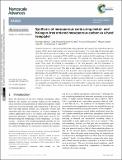Files in this item
Synthesis of mesoporous ceria using metal- and halogen-free ordered mesoporous carbon as a hard template
Item metadata
| dc.contributor.author | Sakina, Farzeen | |
| dc.contributor.author | Muñoz-Ocaña, Juan Manuel | |
| dc.contributor.author | Bouziane, Ainuona | |
| dc.contributor.author | Lopez-Haro, Miguel | |
| dc.contributor.author | Baker, Richard | |
| dc.date.accessioned | 2019-11-04T09:30:03Z | |
| dc.date.available | 2019-11-04T09:30:03Z | |
| dc.date.issued | 2019-10-29 | |
| dc.identifier | 262530677 | |
| dc.identifier | bf77638f-96ad-4161-8293-c613cb16c19f | |
| dc.identifier | 85075975701 | |
| dc.identifier | 000501347800017 | |
| dc.identifier.citation | Sakina , F , Muñoz-Ocaña , J M , Bouziane , A , Lopez-Haro , M & Baker , R 2019 , ' Synthesis of mesoporous ceria using metal- and halogen-free ordered mesoporous carbon as a hard template ' , Nanoscale Advances , vol. Advance Article . https://doi.org/10.1039/C9NA00482C | en |
| dc.identifier.issn | 2516-0230 | |
| dc.identifier.other | ORCID: /0000-0002-3304-3280/work/64034132 | |
| dc.identifier.uri | https://hdl.handle.net/10023/18837 | |
| dc.description | Authors thank the University of St Andrews for the PhD scholarship of FS. We acknowledge funding from MINECO/FEDER (Projects MAT2017-87579-R and MAT2016-81118-P) and from the European Union’s Horizon 2020 research and innovation programme under grant agreement No 823717 –ESTEEM3. | en |
| dc.description.abstract | Ordered mesoporous cerias were synthesised by employing metal- and halogen- free ordered mesoporous carbons (OMCs) as the hard templates in a ‘nanocasting’ procedure. TEM, small angle (SA) and wide angle (WA) XRD, and N2 physisorption analyses were used to characterise the templates, intermediates and ceria products and electron tomography (STEM-HAADF) was used to explore the 3D morphology of the ceria nanostructures grown within the carbon templates. This allowed the relationships between the structures of the OMC templates and the products to be considered in detail as two parameters were varied. These were: the method of impregnation of the ceria precursor; and the temperature of calcination of the OMC template. Of the four impregnation methods tested, the solid-liquid method was found to be the most successful. This gave a high quality product with the highest yield of uniform mesopores, and crystalline nanorods of ceria arrayed in clear long-range order, as viewed by TEM and determined in SA and WAXRD. The specific surface area and pore volume exhibited by this sample were 111 m2/g and 0.39 cm3/g, respectively. 3D electron tomography reconstructions revealed the presence of a network of ordered, nanoscale, rod-like structures interlinked in a complex fashion. The effect of calcination temperature of the template on uptake of the ceria precursor during impregnation was studied by calcining OMCs at temperatures from 350 to 800 °C and using these as hard templates for the nanocasting of ceria. Of these, the carbon template calcined at 400 °C gave the highest quality product. | |
| dc.format.extent | 11 | |
| dc.format.extent | 1612845 | |
| dc.language.iso | eng | |
| dc.relation.ispartof | Nanoscale Advances | en |
| dc.subject | Ceria | en |
| dc.subject | Template | en |
| dc.subject | Nanocasting | en |
| dc.subject | Ordered mesoporous | en |
| dc.subject | Electron tomography | en |
| dc.subject | QD Chemistry | en |
| dc.subject | NDAS | en |
| dc.subject.lcc | QD | en |
| dc.title | Synthesis of mesoporous ceria using metal- and halogen-free ordered mesoporous carbon as a hard template | en |
| dc.type | Journal article | en |
| dc.contributor.institution | University of St Andrews. School of Chemistry | en |
| dc.contributor.institution | University of St Andrews. St Andrews Sustainability Institute | en |
| dc.contributor.institution | University of St Andrews. EaSTCHEM | en |
| dc.identifier.doi | https://doi.org/10.1039/C9NA00482C | |
| dc.description.status | Peer reviewed | en |
This item appears in the following Collection(s)
Items in the St Andrews Research Repository are protected by copyright, with all rights reserved, unless otherwise indicated.

